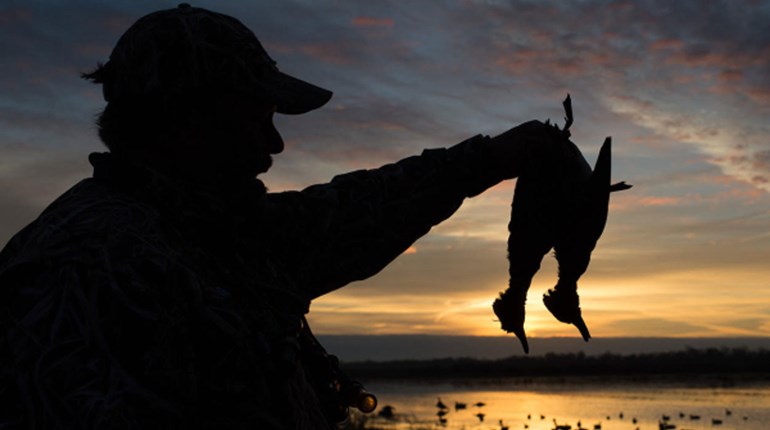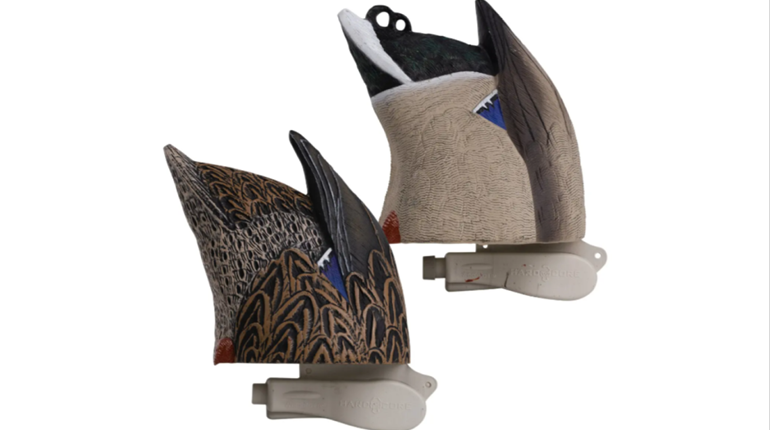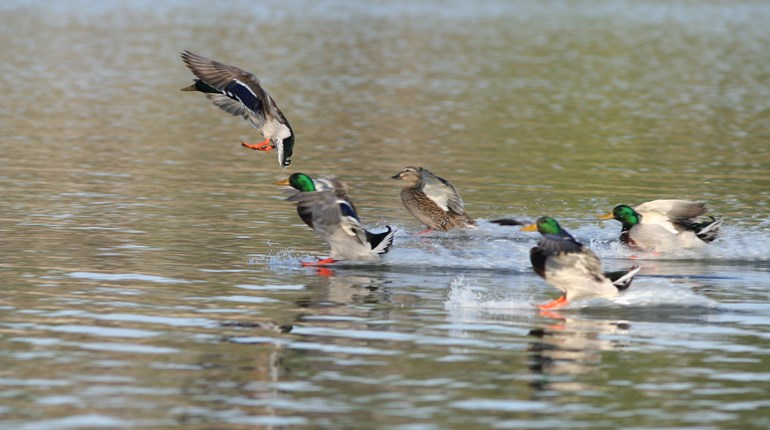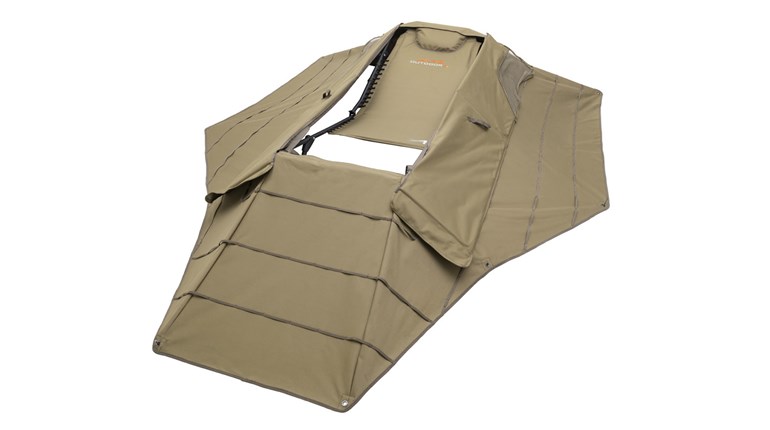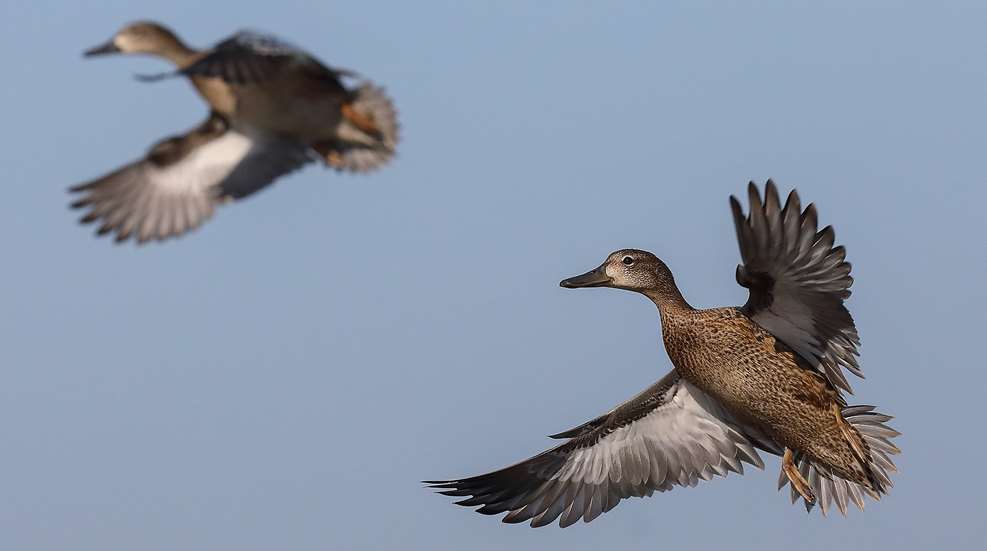
Faint though it was at the moment, sunrise pushed a budding autumnal equinox westward. It, that sunrise, as seen over the vastness of sleepy flat lands, appeared more horizontal than vertical. Sweeps of quiet red and peaceful orange and ribs of thin cloud lay supine atop stubbled fields and thigh-high grasses that taxed the boundaries of vision from left to right.
An initial impression can easily convince one that those platters of buckshot soil mimic a wasteland. Barren. Forlorn. Abandoned even. But that impression is deceiving. In truth, affluence and substance and life are prolific in this Delta, an environment that has for hundreds of years fallen victim to while simultaneously becoming a beneficiary of an often-raging river to the east, as well as smaller rivers miles closer. Here abound waterfowl and whitetails and small game and alligators and birdlife so assorted as to make the observer marvel, coaxing that observer to procure a picture book geared to identification. I was at this locale seeking blue-winged teal.
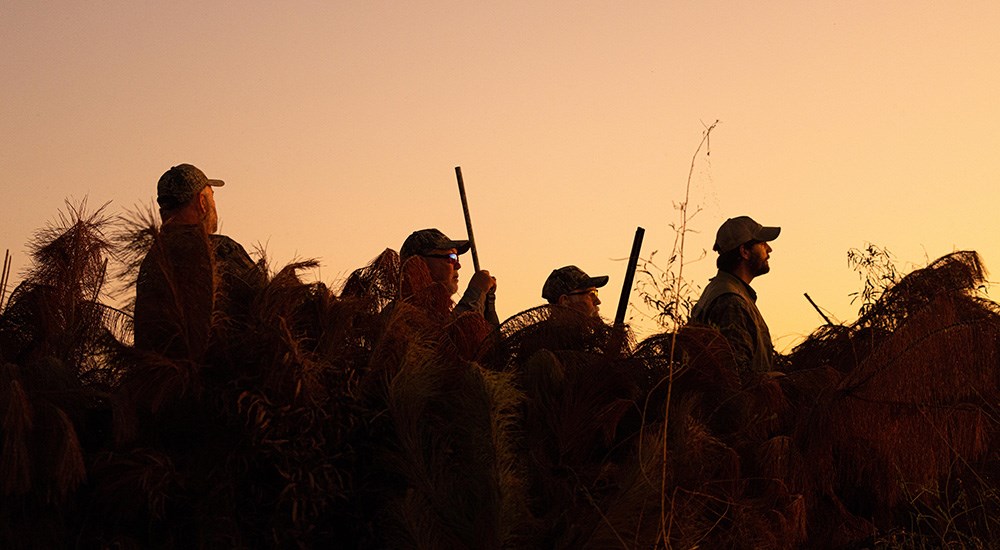
And they were there. Pre-dawn they strafed decoys, disappeared as they swooped low and tall grasses became their background, indicated their arrival with a whispered plop onto shallow water, at times a distant whistle. All these before legal shooting time.
And to the east, with a growing sun providing ample light, roseate spoonbills flew in formation, silhouettes against a brightening sky. When they turned just right in the glow, that pale pink of bodies and more brilliant pink of shoulders and rumps became apparent. Yellowish green heads were discernible on those that came closer.
Directly above, a single pintail—and certainly an early arriver among his kind to this region—circled with curiosity, tempted by that perceived fellowship of the decoys. Two circles, then three, and then he was off to somewhere else in search of respite from his lonesome aloneness. A coot pattered among smartweed. Mosquitoes buzzed. And then it was time. Blue-wings zipped by with little fanfare save their nimble beauty. That was adequate. Shotguns began cracking.
The venue was Honey Brake, an incredible tract of real estate near Jonesville, La. This is the Delta, that alluvial plain of rich land closely associated with the twists and turns and occasional ravages of the Mississippi River. The river has both worked miracles for and delivered heartbreak to those who have chosen to reside within its impact reach, and it, coupled with two other sizable flows near the area, continues to do so with monotonous regularity.
Once a part of the much larger Louisiana Delta Plantation, Honey Brake is now 20,000 contiguous acres given over to wildlife management, specifically waterfowl. The last commercial farm crop was being harvested during the two days of this hunt. From here forward, the property will receive additional management and husbandry with waterfowl its forte. Working closely with the Natural Resources Conservation Service (NRCS), Louisiana Department of Wildlife and Fisheries, Louisiana State University School of Agriculture, as well as other entities such as Ducks Unlimited, studies and research and management programs will be ongoing in the future.
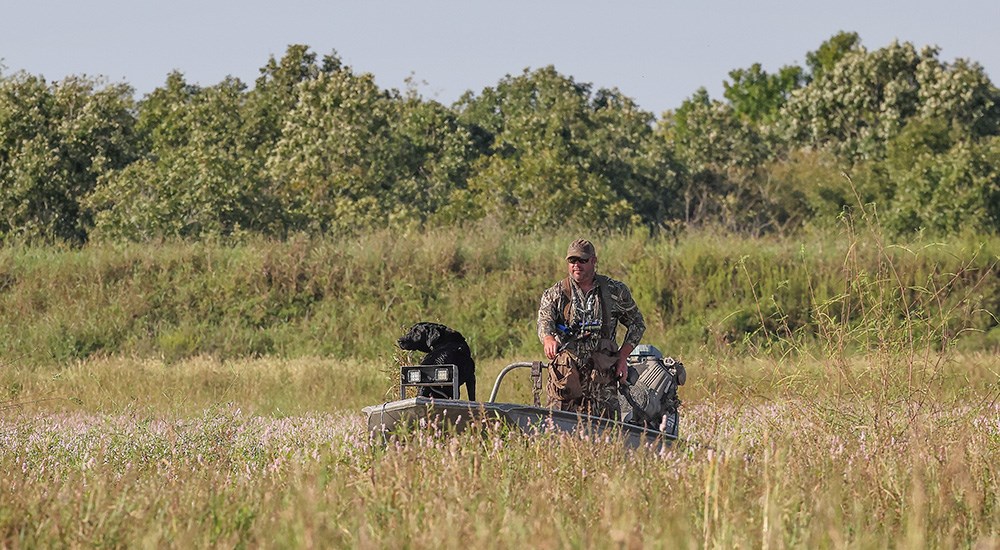 Zinc the Lab keeps watch as Honey Brake CEO and guide Drew Keeth takes the boat through natural grasses to collect the hunters.
Zinc the Lab keeps watch as Honey Brake CEO and guide Drew Keeth takes the boat through natural grasses to collect the hunters.
WRE (Wetlands Reserve Easement) is the primary program now employed at Honey Brake. This calls for moist soil management. A basic description of this practice is that the soil is disked and allowed to produce growth of natural vegetation: smartweed; sprangletop; millet; a multitude of other plants. Waterfowl flock to them. Additionally, new shallow pools and twisting canals are being brought online.
And without proclamation from the arrivers—an unnerving practice of teal–a small group dropped with intent from a warming sky and into the decoys. Three shooters in the blind were prepared, I not among the scholarly. Shots to my left; shots to my right. Blue-wings folded, affording a barely audible splash to shallow water. Robert, my comrade to the right, collected a double. Time for the perfected ballet of a fine retriever. The pool was now empty, save those ducks awaiting pick-up.
But that emptiness lasted only a short while, 15 minutes maybe. Common to teal, these little beings have a propensity for return to the hole from which they were ousted. And they did. Pairs; trios; a double handful on occasion. Some zipping low and fast across the water; some diving from above with the same intent as earlier. And more shotguns and retriever work. I took a left-to-right straight ahead with my 28. That 28 was the junior among shooters; 12s and 20s more pronounced. Still, the 28 was fully adequate.
Teal tend to be a curious lot. They are tiny when compared to specimens such as mallards, and these little gems generally play by a separate set of rules. That quick, perhaps silent arrival and commitment mentioned above is an example. Oft times no circling or protracted decision-making. They are just there, pouring from the sky or scooting in a few feet above water, ready to settle and fraternize. A viable admonition to those hoping to shoot teal is adequately expressed in two words: stay ready.
There are three species of teal common to North America: blue-wings, green-wings and cinnamon. The latter is generally a creature of the West. Green-wings tend to hold tight in their northern climes as long as possible and migrate fairly late to more southern habitat. Blue-wings, though small they are, face a long flight and abandon their Prairie Pothole nesting grounds early in favor of locales to the south. These diminutive speedsters winter as far north as Florida and the Gulf Coast but also venture as far south as Central and South America. It is these, the blue-wings, that afford some very fine and early action along their chosen routes.
Another flurry presented. Off in the distance—relatively speaking. Coming strong toward the blind, not left-to-right or right-to-left. Straight on. A few seconds of making ready for those shotgunners who had not made ready. Then shots. Some birds dropped. Two teal immediately gained elevation and climbed overhead. Two shooters performed an adroit contortion up and back. They scored, the teal falling into tall grasses just behind the blind.
While the shooting was rich and the quiet discussions among like-minded, duck-blind comrades rewarding, I felt a particular fascination with the retriever. During those intriguing moments before legal shooting was announced he, a big Lab, sat off my right shoulder. Zinc. A handsome and focused specimen. Drew Keeth, CEO of Honey Brake and our guide that morning, said Zinc was 12. He had more than a decade of full service in this esoteric euphoria known as duck hunting. Zinc trembled and kept his nose pointed skyward but otherwise remained a statue. No infractions; no scurrying about. Only statue-like. I contemplated his age and began to relate his to my own.
If we take that seven-to-one formula so often accepted, Zinc was even older than I. Several years if figures are correct. And that trembling he exhibited was not from chill or fear or anxiety; these were not present. Rather, his trembling was clearly a function of anticipation, a function of the thrill of being and doing exactly what he now was being and doing. An episode of deep diving into my core engulfed, put me on alert and somewhat troubled my thoughts.
I concluded that Zinc had recognized his master early on. Instructions given by that master were internalized and practiced so that Zinc became productive. He knew his purpose. That purpose was to obey his master’s commands and accomplish the job given. That job was to retrieve ducks. He did so with no hesitation; he did so with determination and drive and skill and vigor, though an aging hip or some other joint must surely have annoyed him on occasion. He performed flawlessly and upon command, this restricted to a simple wave of the hand from his master. And Zinc would continue to do that for as long as his body permitted.
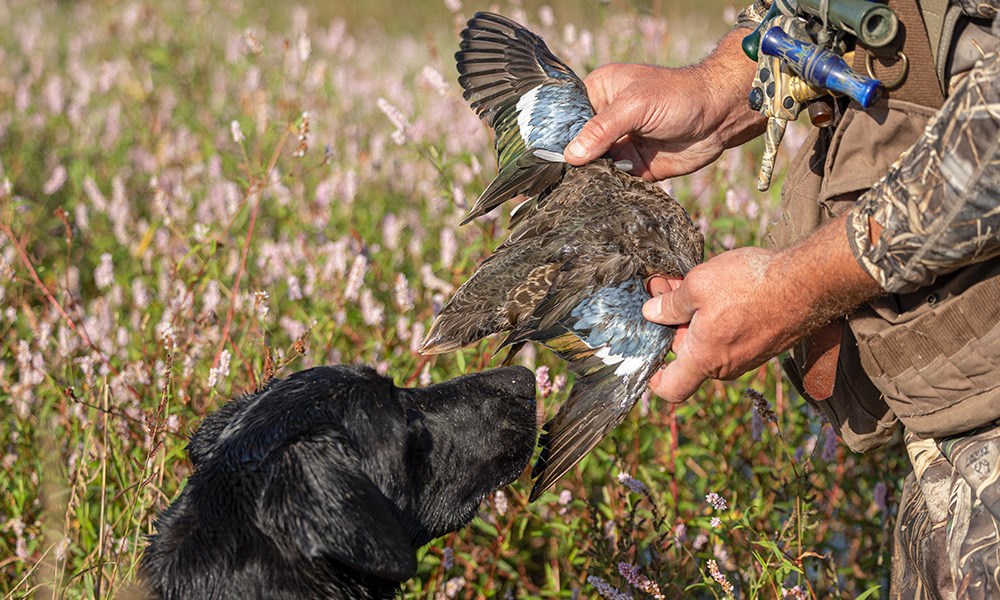
A sobering thought emerged as I considered all this. That thought: how very much like or perhaps unlike that dog we humans can be. I elect—or at least hope I do—to be like him regarding those positive elements observed, but being the weak human that I am, I often miss the path. I pledged anew right there in that duck blind to follow the proper instructions and commands from a source far greater than I, to recognize and better know my purpose, and to remain fully involved in the execution of that purpose for as long as this human condition of physical and mental decline allows, this accomplished with dignity and gentleness and unwavering devotion, just as Zinc was doing. And I hoped then and hope now that I shall always tremble in anticipation at the promise of sunrise.
At some point during the morning, an unplanned circumstance exhibited choreography suitable for Broadway. Three teal, a right-to-left overture, jetted in front of three shooters—Robert on my right, Mark on my left. The birds were adequately spaced as to prevent collateral mishaps. We three stood, shotguns trained on respective birds. Mark took the lead drake, left; Robert managed the rear flyer, right. I summoned the wherewithal to handle the middle. All three went down. It was a fashionable finale.
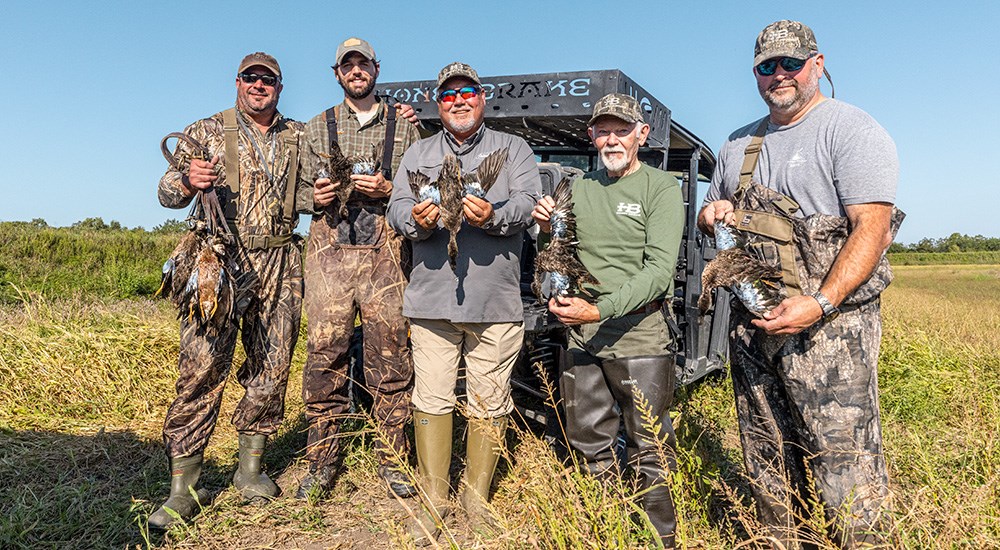 Guide Drew Keeth, left, Dr. Mark McDonnell, Robert Woodall, the author and Bennie Atkinson brandish a morning’s worth a morning’s worth of blue-wings from Honey Brake.
Guide Drew Keeth, left, Dr. Mark McDonnell, Robert Woodall, the author and Bennie Atkinson brandish a morning’s worth a morning’s worth of blue-wings from Honey Brake.
If I were to adjudicate shooting performance, my best came at the end. But in all honesty, even that best does not make me a gold medal claimant, is nothing worthy of a cheering crowd and curtain call. I have mentioned this enough in my writing over 40 years that anyone who has followed those words would consider me dismal in the shotgunning arts. Partially true, that conclusion. But then again, I do things right from time to time. This next was one of those times.
Several birds, diagonal to the blind and entering the stage on my left, bore hard to the decoys. A blast or two, and then a single opted for altitude. Now at a 45-degree angle and climbing slightly to my right. The little 28 again, and that teal sank. My best performance of the day, even in the shadow of that looming drama of three and three mentioned above. And the hunt was over. A thorough check to be sure all things were collected and gear stored for the trip out accomplished, we were transported in a wide boat through the shallows and to a muddy bank 100 yards back toward the road.
During that ATV ride to the lodge, Delta flat land unfolded in every direction. Heavy equipment was scattered about, already working toward more productive enhancement of already-productive habitat. Ducks erupted from shallow waters and docile canals and stands of native grasses. The future looked bright.
A Premier Hunting Lodge
Honey Brake Lodge is a grand venue. Stationed in just the right spot for migrating waterfowl following the Mississippi Flyway, its 20,000 acres on Larto Lake offer ideal conditions for the duck hunter.
I used a Beretta Silver Pigeon 1 in 28-gauge for the teal hunt. And even though this gauge is considered light for many purposes, it worked perfectly from a teal blind. Improvements in ammunition have boosted this little gauge into near celebrity status. It has long been and remains my favorite.
Developments in ammunition have afforded waterfowl hunters some viable choices. This is certainly true with Bismuth. I opted for Boss Shotshells’ copper-plated No. 6 bismuth, 2¾-inch chamber, ⅞-ounce load for the 28 and teal hunting. Boss is a direct-to-buyer establishment. The personnel there are knowledgeable and most helpful. On one order in particular, I found myself in a rush, stopping slightly short of asking for preferential treatment. The loads came right on time!
Choke tubes are the norm now. I screwed in two Carlson’s—an improved-cylinder in bottom and modified in top—while using the Beretta 28 on teal. It was a perfect combo. I will likely change that to Carlson’s modified and full for big ducks.












